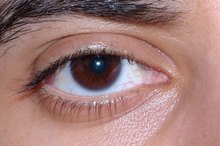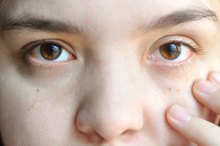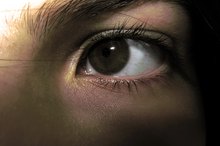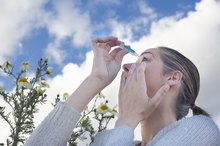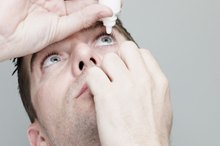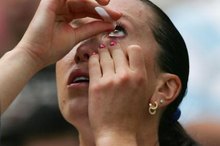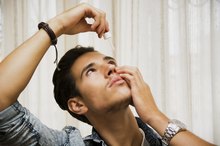What does fact checked mean?
At Healthfully, we strive to deliver objective content that is accurate and up-to-date. Our team periodically reviews articles in order to ensure content quality. The sources cited below consist of evidence from peer-reviewed journals, prominent medical organizations, academic associations, and government data.
The information contained on this site is for informational purposes only, and should not be used as a substitute for the advice of a professional health care provider. Please check with the appropriate physician regarding health questions and concerns. Although we strive to deliver accurate and up-to-date information, no guarantee to that effect is made.
What Is Eye Rebounding?
When people have red, irritated eyes, they often take over-the-counter (OTC) eye drops for instant relief. While the drops can make your eyes look and feel better, frequent use over a long period of time may aggravate the problems. Eventually, the drops' effects will wear off and cause eyes to be even redder and more irritated than before. This condition is known as rebound hyperemia, or eye rebounding.
If you are experiencing serious medical symptoms, seek emergency treatment immediately.
Cause
Many OTC eye drops contain tetrahydrozoline or naphazoline, which are vasoconstrictors that shrink the outer blood vessels in the white parts of the eye (sclera) 3. This in turn makes the eyes appear less red. Decreasing ocular blood flow prevents oxygen, nutrients, and protective defense agents from reaching appropriate structures in your eyes. When you stop using the drops, the oxygen deprived structures send a signal for more oxygen, which causes the blood vessels to become larger and redder than before.
- Many OTC eye drops contain tetrahydrozoline or naphazoline, which are vasoconstrictors that shrink the outer blood vessels in the white parts of the eye (sclera) 3.
- When you stop using the drops, the oxygen deprived structures send a signal for more oxygen, which causes the blood vessels to become larger and redder than before.
Treatment
Redness on Eye Rim
Learn More
If you suspect that you may have eye rebounding, discontinue using the OTC eye drops immediately. Recovery time may vary depending on how long you have been using the drops. The underlying reason for the redness must be identified and treated. There are many causes of a red eye. While only an optometrist or ophthalmologist can diagnose you, in many cases it may be due to Dry Eye Syndrome (DES). Depending on the severity, DES can be treated with artificial tear drops.
- If you suspect that you may have eye rebounding, discontinue using the OTC eye drops immediately.
- Depending on the severity, DES can be treated with artificial tear drops.
Considerations
Eye rebounding may mask a number of eye problems in addition to DES. Some of these conditions are more serious than others. Red eyes may result from an allergic reaction, infection, sun exposure, dust, foreign bodies, trauma, tiredness or a combination of these factors. Some conditions that cause red eye such as glaucoma, require immediate medical attention.
- Eye rebounding may mask a number of eye problems in addition to DES.
- Some conditions that cause red eye such as glaucoma, require immediate medical attention.
Warning
Blood Shot Eyes When Working Out
Learn More
Most of the OTC eye drops with tetrahydrozoline are decongestants 3. These eye drops are easily recognizable because they advertise instant relief for red eyes. Decongestant drops may cause dryness and irritation over time. They may cause stinging or burning of the eye, blurred vision, headaches, sweating, fast or irregular heartbeats, or nervousness. Frequent use may also lead to addiction. Your eyes may become dependent on the drops to stay white, forcing you to use them more.
- Most of the OTC eye drops with tetrahydrozoline are decongestants 3.
- Decongestant drops may cause dryness and irritation over time.
Strategy
If you wish to continue to use the eye drops, make sure you do not use too many drops per dose and limit use to no more than three to four days. Since the drops only treat the symptoms and not the cause of the redness, it is best to consult an optometrist or ophthalmologist to diagnose your problem. The redness may be due to something easily treatable like dry eye or something more serious conditions such as glaucoma.
Related Articles
References
- American Academy of Opthalmology: Using Visine After Cataract Surgery
- American Optometric Association: Dry Eye
- Medline Plus: Tetrahydrozoline Ophthalmic
- American Academy of Ophthalmology. Can you use contact lens rewetting drops to moisten your bare eye? Updated April 23, 2019.
- American Academy of Ophthalmology. Redness-Relieving Eye Drops. Updated August 31, 2018.
- Centers for Disease Control and Prevention. Other Complications. Updated March 21, 2016.
Writer Bio
Anna Lisa Somera is a life science professional, marathoner and triathlete. She holds a MPH and MBA from the University of Illinois at Chicago and a MS in anatomy and cell biology from Rush University. She has been published in peer reviewed medical journals and helped drive the formation of several life science start-ups.
